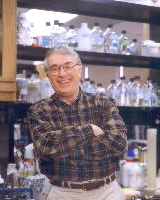 | |||||||||||||||
 |
 |
 |
 |
 |
 |
 |
 |
 |
 |
 |
 |
 |
 |
 |
 |
CSB Core Faculty
- Ray Blind
- Tony Capra
- Walter Chazin
- Steven Damo
- Jamaine Davis
- Martin Egli
- Brandt Eichman
- Steve Fesik
- Tina Iverson
- Lauren Jackson
- Erkan Karakas
- Brett Kroncke
- Borden Lacy
- Galina Lepesheva
- Carlos Lopez
- Terry Lybrand
- Hassane Mchaourab
- Jens Meiler
- Terunaga Nakagawa
- Yi Ren
- Chuck Sanders
- Ben Spiller
- Michael Stone
Emeritus:
- Al Beth
- Paul Bock
- Gerald Stubbs
- Michael Waterman
Michael Waterman
Structure, function and regulation of cytochrome P450 enzymes required for lipid biosynthesis and metabolism

Our research focus is on cytochrome P450 (CYP) structure/function. Of particular interest is the P450 required for sterol biosynthesis (CYP51) and the 18 P450 enzymes expressed in the soil bacterium Streptomyces coelicolor.
CYP51
CYP51 (sterol 14a-demethylase) is the most widely expressed member of the CYP (P450) superfamily of genes. It is found in all kingdoms of life, animals, plants, yeast and fungi, lower eukaryotes and a few bacteria including Mycobacterium tuberculosis (MTCYP51). Unlike eukaryotic forms of CYP51, which are membrane bound, the bacterial forms are soluble. Taking advantage of this feature of MTCYP51 we have recently determined the high-resolution crystal structure of MTCYP51 at 2.1 Å.
Sequence alignment of the more than 40 known CYP51 sequences including forms from animals, plants, fungi and bacteria identifies about 40 amino acids that are conserved across more than 400 million years of evolution. We propose that these conserved residues represent the minimal requirement for a sterol 14a-demethylase and have begun a detailed study by mutagenesis in both MTCYP51 and human CYP51 to determine the precise role of each conserved residue in CYP51 structure/function. Combining the biochemical and biophysical properties of these mutants with the known structure of MT CYP51 will permit detailed understanding of why these residues have been conserved over such a long period of evolution
Plant forms of CYP51 have greater substrate specificity than those from other phyla. In fact, certain plant forms (i.e. sorghum) will only use obtusifoliol as substrate. We are using mutagenesis of MTCYP51 and sorghum CYP51 to identify specific residues which influence substrate specificity. Also we will determine the structural basis of azole binding to CYP51. Azole compounds bind directly to the heme iron, inhibiting activity of CYP51 and therefore blocking sterol biosynthesis. Infection by the human pathogen Candida albicans is treated with azole compounds and azole-resistant forms of C. albicans appear which have mutations in the CYP51 gene. We are trying to establish the structural basis for reduced azole binding relative to substrate binding in these mutants
Streptomyces coelicolor P450s
Many bacteria, such as E. coli contain no CYP genes. Others contain one or a very few such genes. However, the actinomycetes Mycobacterium tuberculosis and Streptomyces coelicolor contain 20 and 18 CYP genes, respectively. Being a soil bacterium, Streptomyces has developed two general systems for defense in such a potentially hazardous environment. First, it produces antibiotics which protect it from other organisms which would use Streptomyces as a food source. Strains of Streptomyces produce about 70% of the commercially used antimicrobial compounds for both human and veterinary medicine as well as other important medical compounds such as the antitumor agent, adriamycin. Second, Streptomyces has the capacity to detoxify xenobiotic compounds from its soil environment, thereby protecting itself from mutagens and other poisons. We have begun a long-term project to characterize in detail the structure/function of all 18 CYPs in Streptomyces coelicolor in collaboration with Steve Kelly and David Lamb, University of Wales, Aberystwyth, and Fred Guengerich, Director of the VU Center for Molecular Toxicology. The goals of this project are to develop a rational protocol for design and synthesis of new and potent antibiotics, and to generate modified strains of Streptomyces which can be used for bioremediation of toxic compounds in the environment. The specific aims of this project are: (i) to determine the function of each of the individual S. coelicolor CYPs by disruption of each of the 18 CYP genes and evaluation of resulting phenotypes including ability to kill invading bacteria and identification of changes in profiles of secondary metabolites, (ii) to determine the basis of regulation of CYP expression and activity in S. coelicolor, (iii) to determine the high resolution x-ray structure of substrate-free and substrate-bound forms of the S. coelicolor CYPs, (iv) to establish mutagenesis strategies which will change the activities of the individual CYPs in specific ways, leading to mutant forms of S. coelicolor which will produce novel antibiotics and other medically relevant compounds or will efficiently detoxify mutagens in the environment.
|
VU Home |
VUMC Home |
People Finder |
University Calendar
webmaster- modified on July 03, 2018 |